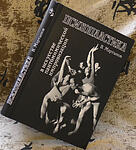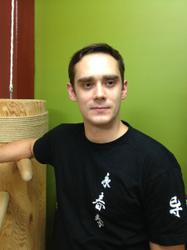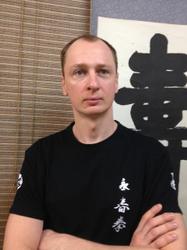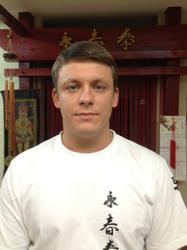Kung Fu, Part 3
THE MAIN PRINCIPLES OF CHI BREATH MANAGEMENT
Chi Breath Management is the brain’s ability to send Chi breath into the required body part. For example, if your liver is in pain, you need Chi breath to go to your liver. Chi breath is concentrated gradually in the desired place.
You may direct Chi breath where-ever you need to. A good way of Chi breath management is to manage your breath by your sight. If you want Chi breath to be sent to your brain, you have to lift your eyes up. If you bring your eyes down then you should look at your feet.
- The heart is the original teacher (general military leader).
- Chi breath is a forward move.
- The eyes are banners and flags’. If the eyes are misty, the sight is not concentrated. You will then not see clear instructions. As a result, motions etc lose their correct sequence: thus the regular sequence of breaths in’ and breaths out’ is disturbed.
- All of the body motions, hand turns and kicks should be mobile’. This mobility is achieved by Chi breath training. A quick movement requires full speed Chi breath. If there is no need to fight, then it is OK. But if combat takes place, then you win!
EYES
The eyes play a major role in martial arts’ practice. You must sharpen your sight’s ability to see an opponent’s form and location (as your eyes turn, your body follows). The heart motions’ should imitate the motions of all 100 of the body’s joints. The essential strength of a human, however, comes from the lungs.
The sequence of breaths in and out as well as the sequence of action and rest’ must to be regulated and controlled by Chi breath, thereby concentrating it in a single bundle’. All body motions are penetrated by one single Chi breath. As a result, the hands and feet become as quick and as strong as a monkey’s.
A human moves with the speed of a lightning flash and, with a cheerful mood, he carries on, having been victorious in combat.
CHI BREATH AND LI STRENGTH
Chi breath circulates in TSZIN-LO channels and in the central nervous system in MAI tendons and channels. A source of LI strength is blood, muscles, skin and bones. If the opponent is strong, then his appearance, skin and bones display an external strength. Internal strength is in his tendons and channels. Chi breath and blood act as an internal strength whereas LI strength acts as an external one. Only when you have fully understood the meaning of Chi breath and blood can you wake the source from which Chi breath and LI strength come from.
The first Chi breath movement occurs. From it comes the LI strength action. When the Cinnabar field is full, there will then be enough strength and breath available.
SECRETS OF A FIST COMBAT
During the fourth phase all joints should be extended and any exhausted Chi breath expended from the body. Nine times up and nine times down to straighten your body parts. Breathing out is like an eagle catching a fish with its claws. A breath out is like a giant pen bird spreading its wings. During Chi hour you must practice exercises with persistence and perseverance. A Wind Shakes a Willow’. The Diamond Fist’ exercise must be executed in the Hai hour. After your meal you must repeat the Metal Finger’ exercise many times. Then, with the sharpness of the hand, break a Wooden Dummy. With an open heart train yourself in the exercise Splitting a brick with a top of your head’. Then, after mid-day, split a stone with an elbow strike. When Chi breath reaches KUN-LUN (the top of your head) carry out the Diamond foot’ exercise. When you are hungry or tired, raise Chi breath by jumping on the wall. Hang sand sacks and stones on your feet and then walk 1,000 li. Then when Chi breath leaves the Cinnabar field, go and brush the garden. When Chi breath gathers in the Cinnabar field, get up like a gust of black wind and fell trees to the ground! When Chi breath exits and reaches the BAI-HUA point, the wind dies down, flies through the market stretching its bow. Then lean forward just like a bow, strike out with your foot in the tiger position, concentrate your Chi breath and return it to the heart. Then send it down to the base of your feet. Chi breath penetrates both feet. You stand like a rider seated on a horse, as stable as a TAISHAN mountain (in other words, steps leading to the sky). If you can transform Chi breath in a combat situation, then you will be able to fly like an arrow shot from a bow at the unimaginable speed of the wind and spirited strength.
All of these are translations from ancient Chinese martial arts writings. Each saying is in code form and everyone who reads it should arrive at the understanding themselves. They should discover themselves how to apply it correctly during the training. Let us look at these writings in a little more detail: they mention hand’ development, training them to attain the hardness of a mortal weapon.
Shaolin Monks were forbidden to carry weapons. It was for this reason they transformed their hands and feet into dangerous weapons, in the process raising their hardness’ to the level of metal.
FIGHTING FISTS
Every day, early in the morning or before going to bed in the evening you should strike a blow with your fist against an internal wall or a wooden board. Every day you should do three complex variations of these, making 50-100 punches within each complex’. Only after three to five months will you notice any results. Every day you should do three to four complex tasks, each consisting of 50 punches. After three to five months, after you have learned to break bricks, move on to breaking stones.
Now we will find out how Shaolin monks did just that.
During the fourth phase, punch a bag of rice, and in the evening under star-light, do the same on a wooden board. At mid-day strike blows upon the lunch table and, after your meal, punch the wall. Your skin will break and blood will spray, but you shall continue your training in both spring and winter.
FINGER STRIKES
You must strive to train and increase the strength of your index finger. For this to occur, Chi breath must leave the Cinnabar field. First you have to strike your finger into the mill flour, then into sand and gravel. Your finger will become red and swell up, but you have to strike 3,800 times. After this the flesh on your finger will be transformed into scabs and blisters. Only then will you be able to strike into metal filings. After you strike nine times a thousand, your finger will burst and the blood will flow. A blister, however, will cover your finger with three new layers and the nail should change three times. This achieved, you will become a man who has himself achieved perfection in martial arts. You will strike the wall and it will immediately cause a hole due to the flesh on your finger having become like metal.
BREAKING STONES WITH THE HEAD
First of all you must stand in the three circles position and summon Chi breath into action five times. At the same time it should leave the Cinnabar field and head to the BAI-HUA point. Now strike yourself on the top of the head and start hitting your skull with your fist, gradually making each successive blow stronger and stronger. Head strikes are done against a wall. One can also break a wooden board. This exercise is better to carry out at mid-day. Whilst training, the tongue should be touching the roof of the mouth, the mouth should be closed and one should breathe through the nose. Chi breath goes through the top of the head. When Chi breath exits, a sharp sound may be heard. During this stage, do not relax your Chi breath.
It should be noted that this training should be carried out under the strict supervision of an experienced Master to avoid various traumas and concussions.
EXERCISES
Let us now look at what different exercises give us, as there are very many of them in various Eastern martial arts schools. I shall give examples of some of them, those I use most regularly in my classes.
· Scratch your ear with you shoulder. This helps the head vessels return to normal, reducing tiredness and irritation, removing strain from the shoulder area.
· Dancing snake: warming up of the muscles in the small of the back increases the spine’s mobility and has a positive effect on headaches.
· Massage your knees. This has a good toning effect.
· Snake ring: this increases mobility in the coxofemoral joint.
· Snake playing with its tail: this tones the nervous system.
· Defeated by a dragon: this fortifies your abdominal region.
· Python ready for a throw: consists of massaging the reflexogenic zones of the small of the back with the back of the hand. This is connected to the urogenital and central-nervous system. It helps prevent aches and pains in the small of the back.
· Snake bites its tail: massaging movements on the active zones of the ankles and toes. This is connected to the operation of the nervous system responsible for the sight- and hearing organs and the internal secretion glands.
· Hands push to the sky: this is employed to restore the breath and the skill is to combine tension and relaxation when breathing in and out.
· Snake raises its head: helps warm up hand joints and works on exercises such as the hand-snake’ used in martial arts drills.
· Throw a look back. To eliminate exhaustion and avoid the seven illnesses (heart, liver, spleen, lungs and kidneys, as well as urogenital disorders).
FINGERS
It is believed that every finger has a connection with a particular cosmological origin (the five elements of traditional Chinese philosophy which are metal, fire, water, wood and earth).
Or possibly something else? Take the NINDZUTSU school, for example. The thumb corresponds to emptiness (the beginning and the end point of all things). The index finger corresponds to the wind and to any gas substance and is responsible for wisdom and virtue.
The middle finger (a burning fire) represents the mind and aggression.
The fourth finger (water and liquids) controls the body’s activities and emotions. The little finger (earth) corresponds to the steadiness of a person in an ever changing world.
The right hand is positive (Yin), exerting an energy. The left one is passive (Yan), and absorbs the energy. By closing the thumb and the fourth finger into a circle, the mind’s adaptability and flexibility rise. KUDZI-IN fingers interweaving guides Chi circulation towards a special trajectory. One finger exercise calms the mind, another gives strength and the third gives adaptability in extreme situations.





 Коан – вопрос к членам Федерации Юн Чун Цюань от президента В.В. Мартынова: «Что Вы сделали для Федерации из того, что не мог бы сделать любой другой за деньги?»
Коан – вопрос к членам Федерации Юн Чун Цюань от президента В.В. Мартынова: «Что Вы сделали для Федерации из того, что не мог бы сделать любой другой за деньги?»


